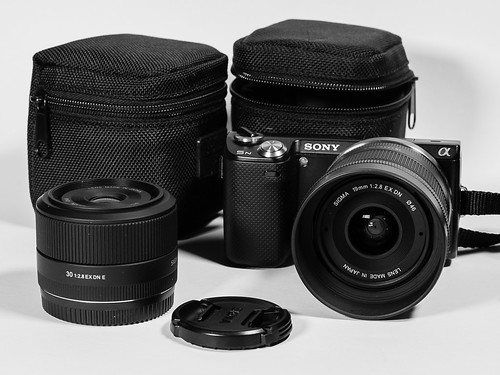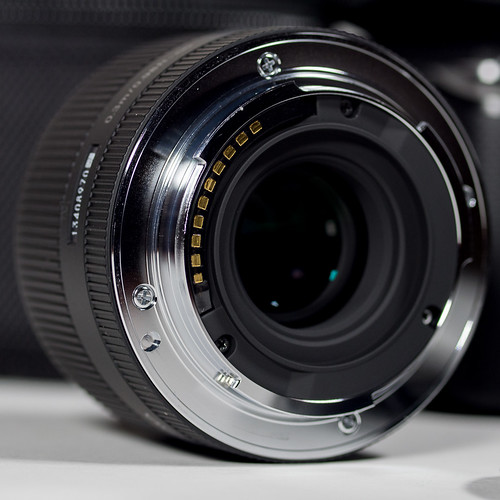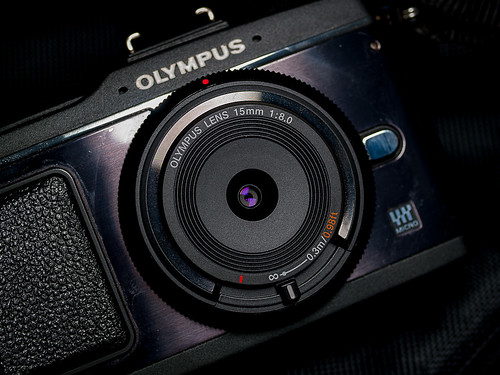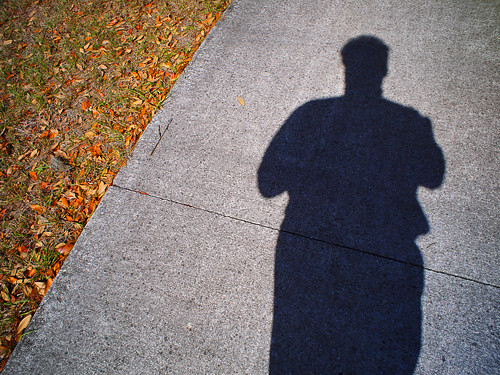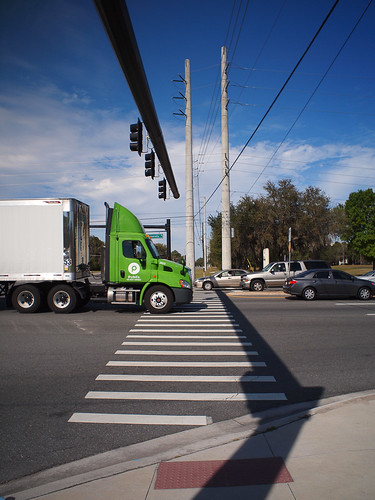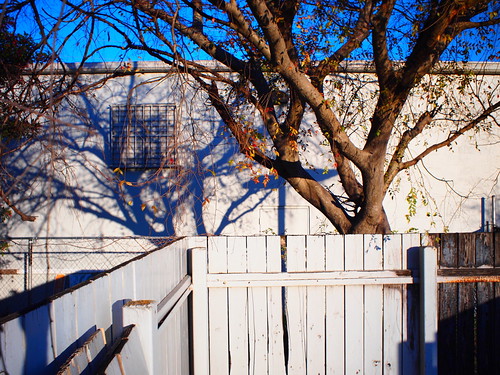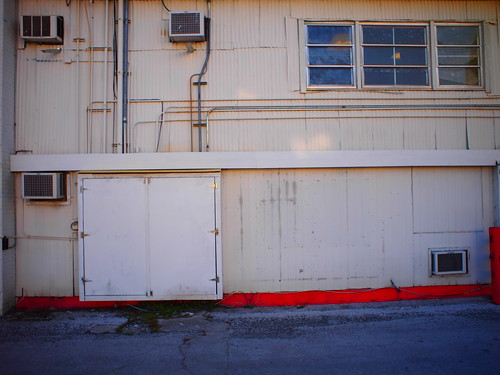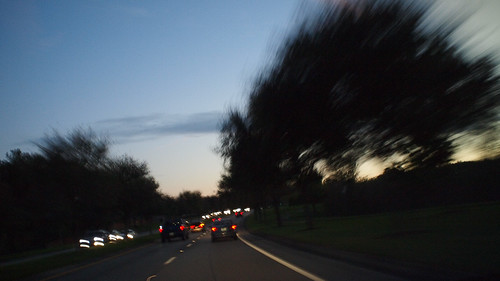
Concept: 2 out of 5
Execution: 4 out of 5
Yeah, but: Never too late for a happy kidhood.
The Long Version: Driving around in circles is just pretty dumb, and that's where all of my radio-controlled car purchases have ended up. So I've mostly learned to resist the siren call of toys that would amuse a 12-year-old, no matter how much I think I would really like one, and have missed out on the whole remote-controlled helicopter thing until now.

Concept: 2 out of 5
Execution: 4 out of 5
Yeah, but: Never too late for a happy kidhood.
The Long Version: Driving around in circles is just pretty dumb, and that's where all of my radio-controlled car purchases have ended up. So I've mostly learned to resist the siren call of toys that would amuse a 12-year-old, no matter how much I think I would really like one, and have missed out on the whole remote-controlled helicopter thing until now.
Penny went to Radio Shack and bought me the "Propel RC Stealth Flyer II" – hereafter 'toy helicopter' – for Christmas. This is a small and simple toy, being seven inches nose-to-tail with a six inch rotor span, weighing nothing, and with only throttle and direction controls. There's no ability to hover or control its speed, and it invariably turns quickly in one direction and slowly in the other, so even that expectation of left-right control is somewhat illusory. This is not a precision machine.

But complexity is not a prerequisite for enjoyment. The toy helicopter gives just enough control to influence its actions but not enough to be accountable for the results. When it crashes – and it will crash, and often – it's just an amusing little wince, and when a flight ends in a wheels-down landing I feel a completely unjustified sense of accomplishment.
The toy helicopter has a surprising amount of power, so it's very easy to over-do the throttle and send it crashing into something. Even a measured and controlled flight is likely to involve impacts, and I'm continually amazed at the incredible durability of this toy. It routinely sucks itself into the ceiling – the opposite of ground effect – and then tumbles to the floor, and/or crashes into walls, and seems to have a magical attraction to the back of the couch. I've worn the paint from its nose and scoured the top pair of rotor blades, but it still flies like a champ.

The easiest way to launch the helicopter is to hold it by the tail and run up the rotors until it's stable and generating enough lift to hold itself up. It's very easy to over-do the throttle, so this allows a measured beginning. This works best when the L/R trim controls have been adjusted for straight flight, because it does take a second or two to have both hands back on the remote.
Taking off from a hard, smooth surface is challenging. Despite the twin counter-rotating propellers the helicopter will still torque itself around and end up heading off in an unexpected direction. Couple that with the extra bolt of power needed to get airborne, and the necessity of throttling down in anticipation of its slow reaction times, and it's likely to end in tragedy. Or in amusement, depending on your perspective.

Launching from an upholstered surface that keeps the helicopter facing forward helps tremendously. One of the challenges that I set myself is to start from my desk chair, fly across the dining room, maybe throw in a quick circle of the living room, and then land on the couch. In the fifteen or twenty short flights that I manage on a charge maybe one will end in triumph, while the rest end in amusement.
The helicopter recharges by tethering it to the controller; the infrared controller runs on six AA batteries, and they last a surprisingly long time. As the helicopter's power runs down it gradually loses the ability to lift itself, so there's plenty of warning that it needs to recharge. By then it's usually time to put it away before someone gets hurt, so it's all for the best.

A nice touch with the helicopter is that it has white and blue LED running lights on the nose and tail, respectively, which makes it a lot of fun to fly in dimmer light. They're also quite practical, as otherwise it can be tough to see which way the helicopter is facing from one moment to the next. And given how quickly it can spin this can be very important.
The LED lights have another practical application as well. To sync up properly the helicopter needs to be turned on before the controller; when they're communicating the `copter's rear blue LED gives three quick flashes and then continues to blink. If the helicopter's unresponsive and the lights are solid, just flip the controller off and on again. Propel RC gets bonus points for combining 'fun' with 'functional' – how often does that happen for inexpensive electronic toys?

The toy helicopter is surprisingly loud; I can only use it when Penny's not home because just hearing it from another room – whirring away and abruptly crashing into things – stresses her out. The abrupt ends of each flight can be a little intimidating, but the combination of hinged rotor blades and extremely light weight means that the helicopter has yet to break anything. And yes, I've flown it into myself on occasion, and while it doesn't tickle, it also doesn't cut or bruise. The key is to cut power when there's an impending impact and let the helicopter fall where it may.
This toy helicopter has struck – if you'll pardon the pun – an excellent balance. It's durable and powerful enough to enjoy, and not so expensive that I'm concerned about hurting it. It gives enough control to be fun but not enough to be the helicopter equivalent of the predictability of driving around in circles. It's one of those rare times that something "better", in whatever way that means, probably wouldn't be an actual improvement. Two months after Christmas I'm still using and enjoying it, which is pretty awesome for a toy that's meant for a twelve-year-old.
last updated 25 feb 2013
Penny went to Radio Shack and bought me the "Propel RC Stealth Flyer II" – hereafter 'toy helicopter' – for Christmas. This is a small and simple toy, being seven inches nose-to-tail with a six inch rotor span, weighing nothing, and with only throttle and direction controls. There's no ability to hover or control its speed, and it invariably turns quickly in one direction and slowly in the other, so even that expectation of left-right control is somewhat illusory. This is not a precision machine.

But complexity is not a prerequisite for enjoyment. The toy helicopter gives just enough control to influence its actions but not enough to be accountable for the results. When it crashes – and it will crash, and often – it's just an amusing little wince, and when a flight ends in a wheels-down landing I feel a completely unjustified sense of accomplishment.
The toy helicopter has a surprising amount of power, so it's very easy to over-do the throttle and send it crashing into something. Even a measured and controlled flight is likely to involve impacts, and I'm continually amazed at the incredible durability of this toy. It routinely sucks itself into the ceiling – the opposite of ground effect – and then tumbles to the floor, and/or crashes into walls, and seems to have a magical attraction to the back of the couch. I've worn the paint from its nose and scoured the top pair of rotor blades, but it still flies like a champ.

The easiest way to launch the helicopter is to hold it by the tail and run up the rotors until it's stable and generating enough lift to hold itself up. It's very easy to over-do the throttle, so this allows a measured beginning. This works best when the L/R trim controls have been adjusted for straight flight, because it does take a second or two to have both hands back on the remote.
Taking off from a hard, smooth surface is challenging. Despite the twin counter-rotating propellers the helicopter will still torque itself around and end up heading off in an unexpected direction. Couple that with the extra bolt of power needed to get airborne, and the necessity of throttling down in anticipation of its slow reaction times, and it's likely to end in tragedy. Or in amusement, depending on your perspective.

Launching from an upholstered surface that keeps the helicopter facing forward helps tremendously. One of the challenges that I set myself is to start from my desk chair, fly across the dining room, maybe throw in a quick circle of the living room, and then land on the couch. In the fifteen or twenty short flights that I manage on a charge maybe one will end in triumph, while the rest end in amusement.
The helicopter recharges by tethering it to the controller; the infrared controller runs on six AA batteries, and they last a surprisingly long time. As the helicopter's power runs down it gradually loses the ability to lift itself, so there's plenty of warning that it needs to recharge. By then it's usually time to put it away before someone gets hurt, so it's all for the best.

A nice touch with the helicopter is that it has white and blue LED running lights on the nose and tail, respectively, which makes it a lot of fun to fly in dimmer light. They're also quite practical, as otherwise it can be tough to see which way the helicopter is facing from one moment to the next. And given how quickly it can spin this can be very important.
The LED lights have another practical application as well. To sync up properly the helicopter needs to be turned on before the controller; when they're communicating the `copter's rear blue LED gives three quick flashes and then continues to blink. If the helicopter's unresponsive and the lights are solid, just flip the controller off and on again. Propel RC gets bonus points for combining 'fun' with 'functional' – how often does that happen for inexpensive electronic toys?

The toy helicopter is surprisingly loud; I can only use it when Penny's not home because just hearing it from another room – whirring away and abruptly crashing into things – stresses her out. And as my audio recording of the helicopter attests, the abrupt ends of each flight can be a little intimidating, but the combination of hinged rotor blades and extremely light weight means that the helicopter has yet to break anything. And yes, I've flown it into myself on occasion, and while it doesn't tickle, it also doesn't cut or bruise. The key is to cut power when there's an impending impact and let the helicopter fall where it may.
This toy helicopter has struck – if you'll pardon the pun – an excellent balance. It's durable and powerful enough to enjoy, and not so expensive that I'm concerned about hurting it. It gives enough control to be fun but not enough to be the helicopter equivalent of the predictability of driving around in circles. It's one of those rare times that something "better", in whatever way that means, probably wouldn't be an actual improvement. Two months after Christmas I'm still using and enjoying it, which is pretty awesome for a toy that's meant for a twelve-year-old.
last updated 25 feb 2013





